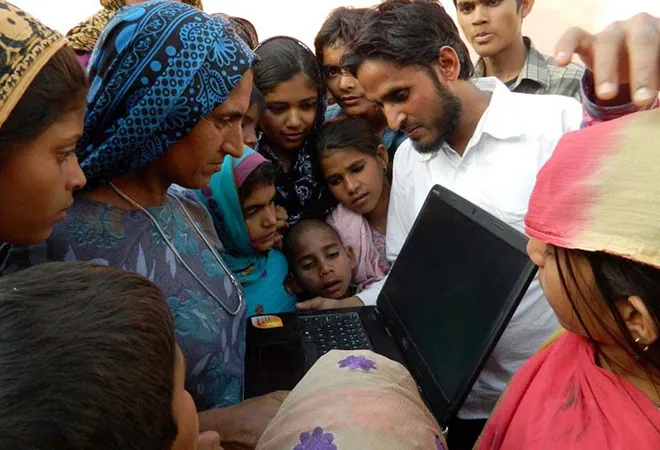
The world boasts of championing a digital revolution while almost half of its population remains offline. This is exactly India’s digital story. Although about 630 million Indians are internet subscribers, for every one subscriber, there is at least one who is not. The digital divide in India is quite compelling. The average internet density in the country is about 48.4 percent; in rural India, it is about 25.3 percent while being around 98 percent in urban India. The country has over a billion active mobile phone subscribers, of which 530 million are smartphone users.
On the flip side, while half of the Indian male population owns a mobile phone, less than one-third of the female population does so. Digital empowerment is not just about accessibility, it is also about functionality. According to a report, no more recent than September 2018, by the Digital Empowerment Foundation, about 90 percent of the Indian population is digitally illiterate.
The above statistics imply that India faces digital poverty. What exactly is digital poverty? It refers to the deprivation related to access to basic telephony services, mobile phones, personal computers or laptops, mobile networks, the internet, the lack of digital literacy and the inability to access opportunities that follow from such impoverishments. Digitalisation is celebrated because it enhances one’s capability to live a life that one values and has reason to value. Digitalisation is a synonym for efficiency, productivity, increased opportunities and progress, and for the most unenviable people, it is a chance to undo the shackles of poverty. To quote Dr. Mukhisa Kituyi, UNCTAD Secretary-General, “Digitalisation is more than an economic tool. It is a weapon against hunger, disease, and climate change.”
It is worth emphasising through examples what problems digitalisation can leapfrog, and what dreams and aspirations it can make come true. The discussion below is only illustrative and by no means exhaustive. Consider the case of M-Pesa, the first mobile money service in Kenya. This service facilitates the use of money in a convenient, safe and quick manner. As a result of M-Pesa, rural incomes in Kenya have spiked by about 30 percent. It has also improved the flow of remittances and savings, and the manner in which risk is managed across Kenya.
It would immensely benefit India to have its own version of the M-Pesa app, designed in a way that understands India’s reality. Evidence from the developing world demonstrates that mobile banking has increased the savings capacity of individuals by decreasing unnecessary expenditures and the dependence on informal mechanisms of savings.
The convergence of agriculture and digitalisation is being leveraged to liberate several poor farmers from their woes. These farmers benefit from these applications which increase efficiency at every stage of the agricultural value chain. For example, the app NAPANTA allows farmers, with just a mobile internet connection, to obtain real time information on more than 3,500 markets and more than 300 commodities. Agriapp assists farmers in getting access to all the agriculture apps, horticulture apps and animal husbandry apps available in Google Playstore. It also provides end-to-end information to farmers about every crop. Another app called the RainbowAgri enables the farmer in many ways; allows for enumeration of output produced, determination of the price at which the farmer is willing to sell his produce, a view of the list of potential buyers and sellers, and a notification if a suitable buyer comes along.
Informal workers can expand their business through digital means. Own account workers such as carpenters, plumbers, technicians etc. can keep in touch with customers and make new customers through WhatsApp and other such applications.
Enterprises and individuals operating in the informal sector are regarded as risky, expensive and low-quality credit assets by banks. Such persons are unable to furnish collateral and the necessary documents for accessing formal credit. Fin-techs offer collateral-free lending facilities and assess credit-worthiness in an innovative manner. It involves the evaluation of call records, transactions and payments behaviour as well as psychometric data to ascertain a potential borrower’s credit-worthiness. BharatPe is doing the same in the context of small shopkeepers and retailers. It offers collateral free loans; the credit limit being based on the shopkeeper/retailer’s transactions on BharatPe QR. The Internet is a treasure trove of knowledge and information. There are several online learning materials available for people across the spectrum of educational qualification.
The Digital India initiative launched by Prime Minister Modi in 2015 has been driven by three key objectives: the establishment of digital infrastructure, provision of public services via the digital mode and financial assistance to citizens, and improvement of the level of digital literacy and awareness.
The Digital India initiative has been quite successful in several respects: 1.19 lakh gram panchayats connected via optical fibre under the BharatNet initiative; 3.65 lakh Common Services Centres providing about more than 350 government services have been set up; 2.39 crore people use digilockers; 2.30 crore people have been enrolled, of which 22 lakh have already completed training under the Digital Saksharta Abhiyan; 7.45 lakh crore have bank accounts under the Total Direct Benefit Transfers scheme; there are about 2.50 crore e-pensioners; 81.40 lakh users of the MyGov app; 10.49 crore transactions on the e-hospital app; 1.4 crore scholarship applications registered under the National Scholarship Portal; e-shakti has covered 4.38 lakh SHGs and 46.83 lakh women members; 10.8 crore cases have been registered using the e-courts app; about 4.5 crore downloads of the BHIM app.
Despite the above mentioned and many more achievements, the Digital India campaign leaves much to be desired in terms of coverage and implementation in a nation as large as India. There are about 43,000 villages that are yet to be connected to basic telephony services. The digital poverty facing India has prevented the Digital India campaign from becoming a universal success. Poor internet connectivity, weak network strengths in connected areas, digital illiteracy and inability to understand new technologies have proven to be major setbacks.
The digitalisation phenomenon has created new avenues of opportunity, both economic and educational. It provides a new platform for showcasing novel ideas, building conversations around important issues and forging new relationships. Digital poverty deprives individuals of such opportunities and platforms. This is a great loss. As a nation committed to the Sustainable Development Goals in general and to ending poverty in all forms in particular, eliminating digital poverty becomes incumbent on India. Furthermore, as we launch into the 4IR, eliminating digital poverty becomes a necessity for maintaining growth rates and the level of development the nation aspires to achieve. Given that the Digital India campaign is expected to play a central role to achieving the newly set goal of transforming the nation into a five trillion-dollar economy by 2025, tackling digital poverty needs to take precedence.
The views expressed above belong to the author(s). ORF research and analyses now available on Telegram! Click here to access our curated content — blogs, longforms and interviews.




 PREV
PREV


